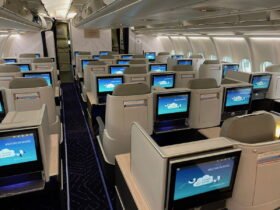Southwest Airlines Reveals Strategy: Unprofitable Hawaii Flights Protect Prime Gate Access
Brian Sumers of The Airline Observer has some really interesting commentary from Southwest Airlines Chief Operating Officer Andrew Watterson about the airline’s Hawaii operation. Much of it centers not on their flights from the West Coast to Hawaii, but on their substantial operation flying between the islands. The performance of these routes is absolutely brutal, yet Watterson says they still make sense.
- Southwest’s load factors on these routes run from 32% (Maui – Lihue) to 57% (Honolulu – Hilto).
- Average fares run in the $40s each way, often around 15% – 30% below what Hawaiian achieves on the same routes.
Southwest Airlines in Honolulu
Watterson says one of the things they’re dealing with is that tourists just don’t island hope the way that they used to as Sumers notes:
[T]he number of visitors who visit more than one island has fallen 15 percent compared to 2019, equating to about 700 fewer people per day.
However, on the plus side:
- They’re already sending these planes to Hawaii, and many would otherwise sit on the ground waiting for the flight times customers want
- In some cases they’re able to use crew with extra legal duty hours, rather than fresh dedicated crew
- Interisland flying gives Southwest more reach in the islands and also connectivity that helps fill planes between Hawaii and the Mainland. Some of their revenue from mainland-Hawaii flying should, therefore, be attributed to these short hops.
At the same time, their Hawaii operation needed a dedicated base, and dedicated sales support. They even added a spare plane. So it’s not all flying at the margin. And these flights are more expensive than expected – they planned to be flying a Boeing 737 MAX 7 which is smaller and supposed to be less expensive to operate than a MAX 8.
What stood out to me, though, is the argument that the intra-island flights help get Southwest the most desirable flight times for their mainland schedule. In other words, they are using intra-island flying to squat on gates.
- They need to schedule at least 6 flights per gate to keep preferential use gates.
- If they shrank flying they would give up gates and have to use each gate more – but that would mean spreading out their flights. They’d be able to offer fewer flights at the most desired times.
“The time channels are quite sensitive,” he said. “When people are leaving the West Coast, they prefer to leave not too early in the morning — let’s call it eight-ish plus or minus an hour — and arrive midday into the islands to get to the hotel and have beach time. Then they fly back in the daytime and arrive in the evening. And that means you really want to be able to have access to gates in Honolulu.”
I certainly understand the impetus to do this. They want gates and prime flying times. At the same time, they’re taking up space that others cannot use.
Meanwhile from a government perspective, it’s important to offer airlines certainty that they’ll be able to have gates available once they commence service, while also requiring that committed gate space be used or else it should go to others.
At the same time, the offering of preferential gates based on minimum usage creates an incentive for unnecessary and unprofitable flying (not environmentally responsible!) just to keep out competition.
Once Southwest starts flying Hawaii redeyes (which lets them reach destinations further east) they won’t need as many intra-island flights to maintain six flights per gate. We could see fewer intra-island flights as a result, if redeyes are additive to current Hawaii-mainland operations.
That said, Hawaii surprisingly isn’t the key focus of the airline’s planned new redeye flying.
Although Southwest’s Hawaii operation remains focused on the West Coast – “There will be some in Hawaii,” Watterson said. “The majority will probably be elsewhere.”
While Aruba is Southwest’s biggest Rapid Rewards redemption destination, that’s in large measure because their Hawaii flights are currently only reasonable accessible to West Coast travelers. Hawaii is unquestionably important to Southwest’s redemption program, and therefore to its profitable credit card program.








![$20 Act of Kindness: How a Flight Attendant’s Gesture Changed a Life [Roundup]](https://leftfieldmagazine.com/wp-content/uploads/2024/09/20-Act-of-Kindness-How-a-Flight-Attendants-Gesture-Changed-280x210.jpeg)




Leave a Reply